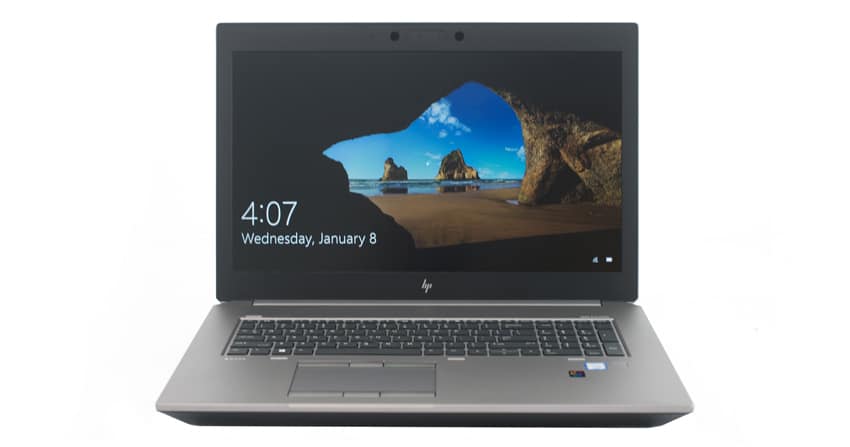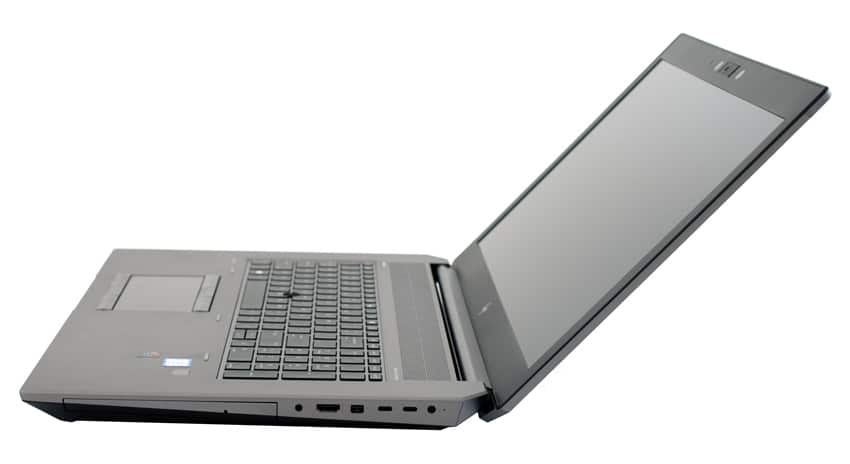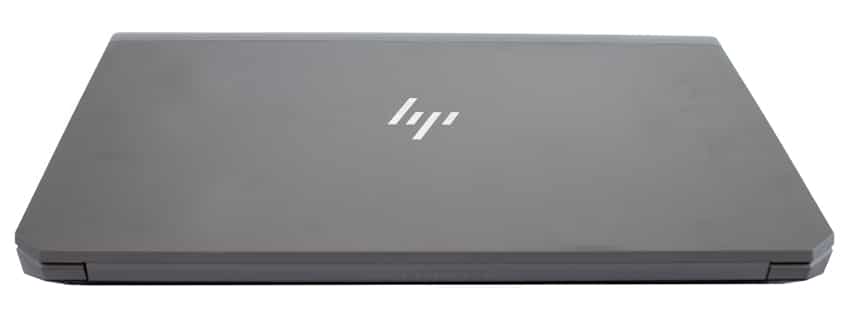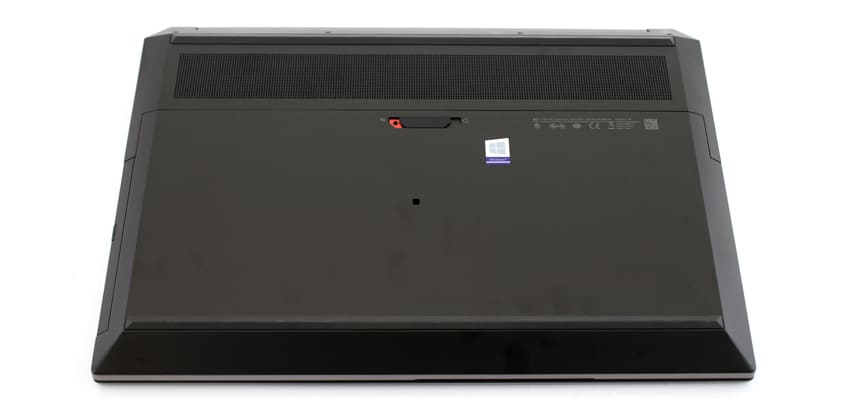The ZBook 17 G6 is the largest model of HP’s new-generation mobile workstations. The 17-inch notebook features some of the same upgraded components as ZBook 15 G6, including the latest 9th Gen Intel Core i9 and Xeon Processors (as high as the 2.4 GHz Xeon E 2286M vPro processor with up to 5.0 GHz via Turbo Boost and support for up to eight cores) and up to 128GB of RAM. One of the biggest advantages of the 17-inch model, however, is the GPU, which features up to the powerful NVIDIA Quadro RTX5000 with ray tracing, deep learning, and advanced shading. The new ZBook can also be outfitted with up to three 1TB PCIe Gen 3 x4 NVMe TLC SSDs and features 3 USB 3.0 ports, 2 USB Type-C ports (Thunderbolt 3 + DP 1.4 + USB 3.1 Gen 2) and an HDMI port.

As indicated above, you can certainly outfit this workstation with some very powerful components. However, there are less expensive options as well to fit different budgets. For example, the ZBook 17 G6 features a wide range of storage options (Up to 10 TB4 of storage along with an optical drive), such as M.2 PCIe, M.2. SATA and 2.5-inch SATA SSDS, while graphics also include less-powerful models like the Intel UHD Graphics 630 and P630 or the NVIDIA T1000, RTX 3000 and RTX 4000.
Like the ZBook 15, the 17-inch model comes with features that focus on collaboration and digital communication. For example, the HP Privacy Camera physically covers the camera when it’s not in use, while the HP Collaboration Keyboard allows users to easily adjust the volume, join/end a call, and mute/unmute people. Moreover, the ZBook 17 G6 comes equipped with a 3rd microphone, which has the ability to picks up other voices around the meeting table. This feature also benefits from HP’s ambient noise cancellation technology.
For this review, our build includes an Intel Xeon E-2286M, a NVIDIA Quadro RTX 5000 (with 16GB VRAM), 32GB (2x16GB) of DDR4 2667MHz RAM, and a 512GB PCIe Gen 3 x4 NVMe SSD. This configuration would go for roughly $4700.
HP ZBook 17 G6 Workstation Specifications
| Form factor | • Full performance design with a sleek look utilizing Aluminum and Magnesium • 33.8 x 416 x 288.4 mm (h x wx d) /1.3 x 16.4 x 11.3 in (h x w x d) • Starting at 7 lb / 3.2 kg |
| Processor | • 9th Generation Quad, Hexa & Octo-core Intel® Core™ and Intel® Xeon® • Intel® Turbo Boost Technology 2.0 support • Mobile Intel® CM246 chipset • Intel® vPro™ support (optional) |
| Graphics | • Intel® UHD Graphics 630, P630 • NVIDIA® Quadro® T1000, RTX3000, RTX4000, RTX5000 • UMA option • OpenGL support/ISV certifications • Support for NVIDIA® OptimusTM |
| Display | • 17.3-inch diagonal FHD UWVA/AG (300 nits) • 17.3-inch diagonal UHD Touch UWVA (400 nits) • 17.3-inch diagonal UHD DreamColor UWVA/AG (400 nits) |
| Memory | • Up to 128 GB nECC DDR4 – 2667 MHz • Up to 64 GB ECC DDR4 – 2667 MHz • 4 dual-sided open SODIMM slots; Standard memory with Intel® CoreTM and ECC available with Intel® Xeon® processors |
| Primary storage | • M.2 PCIe SSD
• M.2 SATA SSD
• 2.5” SATA SSD
• 2.5” SATA HDD with HP 3D DriveGuard (HDD)
|
| Audio | • Bang & Olufsen Audio • Integrated dual-microphone array with third “world facing” mic • HP Noise Cancellation Software • HP Clear Sound Amp • Microsoft Lync Unified Certification (Lync + Skype) • 2 integrated stereo speakers • Collaboration keys built into keyboard |
| Communications | • RJ-45 Ethernet port • PXE boot supported • Intel (I219-LM) Gigabit Network • Intel® AX200 802.11 2x2ax + BT 5 combo (vProTM and non-vProTM) • HP Extended Range Wireless LAN • WWAN Intel® XMM™ 7360 LTE/HSPA+ w/GPS • NFC Mirage WNC XRAV-1 (NXP NPC300 I2C 10 mm x 17 mm) |
| Expansion slots | • Integrated SmartCard reader • Tool less access to storage, memory, battery, and more • Optical Disk Drive |
| Ports | • (2) USB Type-C™ (Thunderbolt™ 3 + DP 1.4 + USB 3.1 Gen 2) • (1) HDMI 2.0 • (1) mDP 1.4 • (1) USB 3.0 charging • (2) USB 3.0 • (1) RJ-45 (Ethernet) • (1) Headphone/microphone-in combo jack • (1) Power connector |
| Input devices/Camera | • Full sized chiclet, island-style optional backlit keyboard w/ numeric keypad, spill resistant design with drain, DuraKey coating, and collaboration keys • Dual point layout with 3 buttons, Image Sensor touchpad with chemically strengthened glass cover – touchpad On/Off control • 1080p FHD webcam with IR camera for facial recognition (optional) |
| Battery | • 95.6 Whr Polymer battery pack – targeted for up to 17 hours of battery life • HP Fast Charge (0 to 50% charge in 45 minutes) |
| Power | • 200 W Slim Smart AC adapter |
| Security | • Smart card reader • TPM 2.0 module • Optional fingerprint reader • Security lock slot • Full volume encryption • HP Sure Start Gen5 • HP Privacy Camera Shutter • IR camera for Windows Hello |
| Operating systems | • Single image/lean • Preinstalled: Windows 10 Home 64 Plus • Preinstalled: Windows 10 Pro 64 • Preinstalled: Windows 10 Pro 64 Workstation • Preinstalled: FreeDOS 2.0 • Supported: Windows 10 Enterprise 64-bit |
| Key options | • Support for HP Thunderbolt Dock G2; HP Elite USB-C Dock • UHD DreamColor display option available |
| Warranty | • Standard: Limited 3-year warranty; on-site service standard APJ • Optional 1-year warranty |
Design and build
The HP ZBook 17 features a nice aluminum build with a metallic finish. It starts at a hefty 7lbs (weight will get higher as you add larger/more powerful components) and is a little over 1-inch thick, so you’ll need a larger laptop bag to transport it, especially due to its large 17-inch screen. That seems reasonable, however, due to the amount of power this laptop packs. It’s target demographic also isn’t those looking for ultimate portability.

On the left side of the ZBook is the Security cable slot, RJ45 port, three USB 3.0 ports (one for charging), and SD Card and Smart Card readers. On the other side is the optical drive bay, Headphone/Microphone Combo, two Thunderbolt 3 USB-C ports, Mini DisplayPort, an HDMI port, and the power connector.
The front-view facing the 17-inch screen shows the backlit keyboard, which features the HP Collaboration Keyboard for easy access to volume adjustment, joining/ending a call, and muting/unmuting people. The touchpad features 3 select buttons on both the top and bottom, with 2-finger scrolling and 2-finger zoom (pinch) on the center pad itself. There’s also a color collaboration sensor for those who have the HP DreamColor display option. Like the 15-inch model, the touchpad itself doesn’t click, only the buttons do, which we found a bit different when browsing the web or doing other types of work.

Along the top is the web cam (which features a handy Privacy Camera Shutter that manually covers the camera to protect users from malicious surveillance), an infra-red camera and the HP World Facing Microphone.
Flipping the 17-inch G6 workstation over shows ventilation, the tool less access lock and keyboard liquid drain hole.

The most powerful GPU option is the NVIDIA Quadro RTX 5000. This PCI Express 3.0 x 16 professional graphics card is powered by the NVIDIA Turing architecture and the NVIDIA RTX platform, and combines ray tracing, deep learning, and advanced shading to work well during graphics-intensive workloads. It features 16GB of GDDR6 memory as well as 3,072 CUDA parallel-processing cores.
NVIDIA Quadro RTX 5000 Specifications
| CUDA Parallel-Processing Cores | 3,072 |
| NVIDIA Tensor Cores | 384 |
| NVIDIA RT Cores | 48 |
| GPU Memory | 16 GB GDDR6 |
| RTX-OPS | 62T |
| Rays Cast | 8 Giga Rays/Sec |
| FP32 Performance | 11.2 TFLOPS |
| Max Power Consumption | 265 W |
| Graphics Bus | PCI Express 3.0 x 16 |
| Display Connectors | DP 1.4 (4), VirtualLink (1) |
| Form Factor | 4.4″ (H) x 10.5″ (L) Dual Slot |
Performance
To gauge the performance of the HP ZBook 17 G6, we put it through three resource-intensive tests. These tests are also designed to measure the capabilities of the equipped Quadro NVIDIA Quatro RTX5000. We will be comparing it to the HP ZBook 15 G6 workstation. This is essentially to demonstrate the difference in performance between the two different sizes. For example, we outfitted the 15-inch model with an Intel Xeon E-2286M CPU, 64GB of DDR4, 2667MHz RAM, 1TB NVMe SSD, and an NVIDIA Quadro RTX 3000 GPU while the 17-inch model is equipped with an Intel Xeon E-2286M, a NVIDIA Quadro RTX 5000 (with 16GB VRAM), 32GB (2x16GB) of DDR4 2667MHz RAM, and a 512GB PCIe Gen 3 x4 NVMe SSD.
This first test is the SPECviewperf 13 benchmark, which is the worldwide standard for measuring graphics performance based on professional applications. SPECviewperf runs 9 benchmarks called “viewsets,” which represent graphics content and behavior from actual applications and include categories such as 3D Max, CATIA, Creo, Energy, Maya, Medical, Showcase, Siemens NX, and Solidworks.
| SPECviewperf 13 | ||
|---|---|---|
| Viewsets | HP ZBook 15 G6 (NVIDIA Quadro RTX 3000) |
HP ZBook 17 G6 (NVIDIA Quadro RTX 5000) |
| 3dsmax-06 | 145.3 | 178.87 |
| Catia-05 | 217.39 | 274.62 |
| Creo-02 | 199.95 | 252.05 |
| Energy-02 | 31.07 | 43.34 |
| Maya-05 | 210.88 | 277.72 |
| Medical-02 | 66.02 | 93.29 |
| Showcase-02 | 71.76 | 94.87 |
| Snx-03 | 224.25 | 372.61 |
| Sw-04 | 143.81 | 162.88 |
As expected, the ZBook 17 G6 recorded very impressive results, though the 15-inch model held its own with a lesser graphics card.
We also ran SPECworkstation3, a test that specializes benchmark designed for testing all key aspects of workstation performance; it uses over 30 workloads to test CPU, graphics, I/O, and memory bandwidth. The workloads fall into broader categories such as Media and Entertainment, Financial Services, Product Development, Energy, Life Sciences, and General Operations. We are going to list the broad-category results for each, as opposed to the individual workloads. The results are an average of all the individual workloads in each category.
| SPECworkstation3 | ||
|---|---|---|
| Category | HP ZBook 15 G6 (NVIDIA Quadro RTX 3000) |
HP ZBook 17 G6 (NVIDIA Quadro RTX 5000) |
| M&E | 2.29 | 2.26 |
| ProdDev | 2.17 | 2.09 |
| LifeSci | 2.1 | 2.17 |
| Energy | 1.37 | 1.48 |
| FSI | 2.14 | 1.78 |
| GeneralOps | 1.72 | 1.64 |
| GPU Compute | 2.79 | 3.25 |
Both ZBook G6 workstations recorded impressive results once again, with the 17-inch edging out the 15-inch model in all categories except media and entertainment.
Next up is the Environmental Systems Research Institute (Esri) benchmark. Esri is a supplier of Geographic Information System (GIS) software. Esri’s Performance Team designed their PerfTool add-in scripts to automatically launch the ArcGIS Pro. This application uses a “ZoomToBookmarks” function to browse various pre-defined bookmarks and create a log file with all the key data points required to predict the user experience. The script automatically loops the bookmarks three times to account for caching (memory and disk cache). In other words, this benchmark simulates heavy graphical use that one might see through Esri’s ArcGIS Pro software.
The tests consist of three main datasets. Two are 3-D city views of Philadelphia, PA and Montreal, QC. These city views contain textured 3-D multipatch buildings draped on a terrain model and draped aerial images. The third dataset is a 2-D map view of the Portland, OR region. This data contains detailed information for roads, landuse parcels, parks and schools, rivers, lakes, and hillshaded terrain.
First up is Montreal. For drawtime, The ZBook 17 G6 posted 00:01:30.2 in average drawtime, and 619.94 and 257.25 FPS for average and minimum FPS, respectively. The ZBook 15 G6 posted an average drawtime of 00:01:30.906, while recording an average and minimum FPS of 498.57 and 217.17, respectively.
| ESRI ArcGIS Pro 2.3 Montreal | |
|---|---|
| Drawtime | Average |
| HP ZBook 15 G6 (NVIDIA Quadro RTX 3000) | 00:01:30.906 |
| HP ZBook 17 G6 (NVIDIA Quadro RTX 5000) | 00:01:30.200 |
| Average FPS | Average |
| HP ZBook 15 G6 (NVIDIA Quadro RTX 3000) | 498.57 |
| HP ZBook 17 G6 (NVIDIA Quadro RTX 5000) | 619.94 |
| Minimum FPS | Average |
| HP ZBook 15 G6 (NVIDIA Quadro RTX 3000) | 217.17 |
| HP ZBook 17 G6 (NVIDIA Quadro RTX 5000) | 257.25 |
Next up is our Philly model, where the 17-inch ZBook showed 00:01:00.233 in average drawtime, 459.43 in average FPS and 211.37 in average minimum FPS. The 15-inch ZBook posted an average drawtime of 00:01:00.233, with an average and minimum FPS of 341.39 and 171.98, respectively.
| ESRI ArcGIS Pro 2.3 Philly | |
|---|---|
| Drawtime | Average |
| HP ZBook 15 G6 (NVIDIA Quadro RTX 3000) | 00:01:01.064 |
| HP ZBook 17 G6 (NVIDIA Quadro RTX 5000) | 00:01:00.233 |
| Average FPS | Average |
| HP ZBook 15 G6 (NVIDIA Quadro RTX 3000) | 341.39 |
| HP ZBook 17 G6 (NVIDIA Quadro RTX 5000) | 459.43 |
| Minimum FPS | Average |
| HP ZBook 15 G6(NVIDIA Quadro RTX 3000) | 171.98 |
| HP ZBook 17 G6 (NVIDIA Quadro RTX 5000) | 211.37 |
Our last model is of Portland. Here, the ZBook 17 G6 recorded 00:00:30.466 in average drawtime, 4,385.22 in average FPS and 1,673.24 in average minimum FPS. The ZBook 15 G6 recorded an average drawtime of 00:00:33.811, while average and minimum FPS showed 4,012.02 and 1,504.01, respectively.
| ESRI ArcGIS Pro 2.3 Portland | |
|---|---|
| Drawtime | Average |
| HP ZBook 15 G6 (NVIDIA Quadro RTX 3000) | 00:00:33.811 |
| HP ZBook 17 G6 (NVIDIA Quadro RTX 5000) | 00:00:30.466 |
| Average FPS | Average |
| HP ZBook 15 G6 (NVIDIA Quadro RTX 3000) | 4,012.02 |
| HP ZBook 17 G6 (NVIDIA Quadro RTX 5000) | 4,385.22 |
| Minimum FPS | Average |
| HP ZBook 15 G6 (NVIDIA Quadro RTX 3000) | 1,504.01 |
| HP ZBook 17 G6 (NVIDIA Quadro RTX 5000) | 1,673.24 |
Conclusion
The HP ZBook 17 G6 is the largest model of the powerful mobile workstation line. As demonstrated above, it has certainly shown that it will excel in pretty much any resource-intensive professional application, and, like the 15-inch model, it is a significant improvement over the previous G5 generation. This is due to more powerful processor, professional graphics, and more RAM options available. The bright and beautiful 100% Adobe RGB UHD display and built in collaborative features all make for a great workstation for professionals on the go who as well as those who do a lot of virtual conferencing. Like all modern laptops, outfitting the ZBook 17 G6 with the higher-end components can get very expensive. But if you’re willing to go deep in your wallets, it’s well worth it for the performance gain. Top of the line build includes an Intel Xeon processor, up to 128 GB nECC DDR4 (2667 MHz), up to three PCIe Gen 3 x4 NVMe TLC SSDs, and an NVIDIA Quadro RTX5000 (16GB memory).
In our performance charts, we compared the HP ZBook 17 G6 to the 15-inch model. Though the ZBook 17 can be outfitted with a better GPU (RTX5000 vs. RTX3000), and therefore produce better numbers, the comparative results will help potential buyers decide if they need the performance of a larger mobile workstation or a ZBook that focuses more on portability. Looking at ESRI ArcGIS Pro performance, the ZBook 17 G6 demonstrated very impressive scores in average FPS and Minimum FPS for all three of our tests. In SPECworkstation3 and SPECviewperf 13, the 17-inch G6 ZBook continued its impressive run during with some of the highest numbers we’ve seen for its class (the 15-inch model held its own with great results as well). Unfortunately, as we mentioned above, users will need to dish out almost $5,000 to see these types of results.
It is interesting to see two RTX GPUs go head to head, knowing how much of an impact the greater card will offer in different workloads. For users that need high end components for their graphic needs, the HP ZBook 17 G6 is sure to deliver. Just keep in mind that you will have to lug around a bit of a bigger device to do so.




 Amazon
Amazon